How we raised $12,000 in 30 days for our feature film.
Note: This is a repost from a post I authored at the TRIUMPH67 website.
Upon first hearing about crowdfunding via kickstarter I was obsessed with how I was eventually going to put it to use on a film project. I had thought it would be for a documentary project that has been in the works for several years, but when we got close to finishing post-production on TRIUMPH67 and ran dry of funds (and time) I reexamined what I thought I knew and realized that kickstarter would be the perfect fit for us to bring the feature film project to completion.
I started following and making mental notes of the various successful campaigns, especially film/movie projects, and began an outline of my favorite techniques and approaches. I stumbled upon another Minnesota filmmaker in the process of a kickstarter campaign, Phil Holbrook and TILT, and made a contribution. His group really seemed involved and motivated and it was easy to become engaged. I was particularly thrilled to see them meet their goal of $15,000!
Then, one project really lit a proverbial fire under my ass: an extremely detailed writeup about funding a book publishing project called “KickStartup” by Craig Mod (thanks for the inspiration, Craig!).
Not only did Craig provide a scintillating story with great pictures, he did some really useful analysis on his numbers and figured out what pledge levels were most productive. I decided it was extremely spot-on, and jived with much of what I had found elsewhere, and went ahead and created our pledge levels at what were the most apparent productive levels: $25, $50, $100, $250, $500, $1000 and $5000. We knew it was a stretch to get anything at or above the $5000 level, but we thought it looked good to have on our campaign! And who knew, maybe some deep-pocketed benefactor would emerge and desire to help TRIUMPH67 (nope, they didn’t).

We launched our kickstarter post-production campaign on October 5th, 2010 and set it for a standard 30-day duration. I would recommend this length as any shorter and it might be hard to build up enough awareness for your project and any longer and you (and your audience) will likely run out of energy to continue the fundraising. However, if you truly believe you can do it in a shorter amount of time, go for it. You will be working hard every day for every dollar in your fund. Can you dedicate 30 days of your life to this? Let me answer that for you: Yes! Of course. This is like free money! Of course, you have rewards you need to fulfill for each pledge and it takes a lot of your time, but you know what I mean. And you are building your audience!
If you read Craig’s story of his campaign you saw that he outlined their strategy for promotion of their fundraiser. They focused on twitter, facebook, emails and online media (blogs and magazines). Their daily approach of tweets and status updates were bolstered with four unique emails to their contact list, each of which meant an approximate increase of an extra $500 in donations. Nice, especially considering that sending emails is super low-cost or even free! The really inspirational bit of information on their strategy was that they got their campaign mentioned on at least fifteen different blog or magazine sites (mainly dealing with design and art). That kind of push and publicity would be phenomenal for any independent filmmaker and we hoped for some of the same.
The T67 Analysis
Here’s the rundown on how we approached our promotion: We knew that the director, Dan, and myself could tweet and facebook on a daily basis, along with supporting help from a few close people. This is where we really took advantage of HootSuite to keep track of what we were doing in separate locations and to not send out redundant posts. Brilliant. Dan and I could quickly and easily see what each other had already posted or scheduled to post and not repeat the same messages.
We had hoped to do more full-on email blasts, but we only did one official TRIUMPH67 email a few days before the end of the campaign, which, tied with the impending end of our campaign, gave us a boost of over $1000 compared to the previous day (which was a Sunday, by the way (weekends were always more challenging)). We did, however, act on our own personal email contacts and sent out several direct messages to our friends, families and coworkers. The great hope we had of getting supportive mentions in media or movie blogs never panned out at all, mostly due to our own lack of effort in this area. This is something I’d recommend not skipping over in your own campaign — build your audience and followers at every step in your filmmaking process and get some media mentions!
Our biggest boost, and perhaps our biggest secret recipe that we stumbled upon and we are now revealing directly to you, was in engaging our connections on Facebook in direct chats. Since this personal, one-on-one communication was almost as good as being face-to-face with our acquaintances, they were far more likely to agree to a pledge. Maybe it was too hard to say no directly to us in this manner or maybe the personal connection was just really convincing, but once we got on this groove, we had our single best day in pledges with over $2800 raised (about 24% of our total)!

In summary, we worked our 30 days pretty hard and consistently, although we weren’t terribly engaged during the four days we were at the wonderful Flyway Film Festival screening our work-in-progress cut of the film and it was patently obvious — we only raised $200 during those four days. Remember, you will work for every pledge.

If you think that you will build it and they will come, you are sadly mistaken.
When you launch your own crowdfunded fundraising campaign, be ready to devote every free moment to working it! We found that tweeting and facebooking at least twice a day seemed to be the right amount of social mentions on our part (with additional retweets or rementions a bonus on top of that) and didn’t seem to alienate or annoy anybody with the frequency. We definitely should have sent one or two more official emails to our list of subscribers (don’t just send one!) and we should have spent more time on some good media/blog mentions. Personal conversations led to our best pledge day and we’d recommend spending time either talking in-person to people or on the phone or chat/Skype/etc. Our first four and our last four days were highly productive, likely due to the excitement of launching and wrapping up our campaign. It was the middle 20 days that were the the long-slog of working hard for every donation, and weekends were just tough in general. If you don’t already have several hundred friends and followers on twitter or facebook (including several who are quite influential themselves), you will have a harder time of effectively running a crowdfunding campaign, so build up your social profile and your respective personal brands, every chance you get, not just when you need to raise money. You may find, as we did, that you will receive donations through other means as well!
After all, people are making a contribution based somewhat on your project, but mostly upon their belief in you.
- Days without a pledge: 2
- Days over $25: 28
- Days over $50: 25
- Days over $100: 19
- Days over $250: 12
- Days over $500: 7
- Days over $1000: 4
- Best day amount: $2830
- Average pledge/day: $379.47
—
Further Reading
See our archive of tweets during our kickstarter campaign:
http://topsy.com/www.kickstarter.com/projects/jwilker/triumph67-0
Read more analysis of kickstarter projects:
http://pdnpulse.com/2010/10/tips-for-successful-fundraising-from-kickstarter.html
http://blog.kickstarter.com/post/1162195899/trends-in-pricing-and-duration
http://gigaom.com/2010/09/22/crowdfunding-kickstarter-has-some-advice/
http://coffeeandcelluloid.com/2010/03/01/behavior-patterns-of-kickstarter-funders/
http://coffeeandcelluloid.com/2010/03/04/how-to-figure-the-true-cost-of-a-kickstarter-project/
http://blog.kickstarter.com/post/5014573685/happy-birthday-kickstarter
http://www.kickstarter.com/blog/10000-successful-projects
(we are in the 5:01 segment of their successful projects video!)
Recently Wonder Russell compiled a list of articles from around the world relating to crowdfunding. This is a great resource, perhaps becoming the actual Crowdfunder’s Bible, (thanks, Wonder!) and it’ll be worth your while to peruse every story prior to launching your own campaign. Learn from those of us who’ve gone first and avoid the pitfalls and mistakes we’ve blundered through!
http://bellawonder.com/2011/07/11/the-crowdfunders-bible/
Please note: kickstarter could just as easily be replaced with indiegogo.com or rockethub.com or ulule.com. As of this writing, kickstarter just simply has the most street cred/reputation. Other sources of crowd or micro funding are: pledgie.com, flattr.com, paypal donations on your own site, etc.
If you found this information useful, please like and follow TRIUMPH67!





